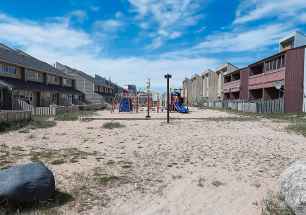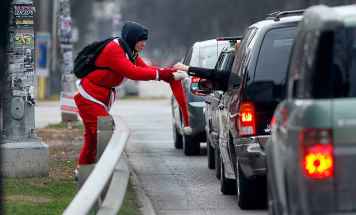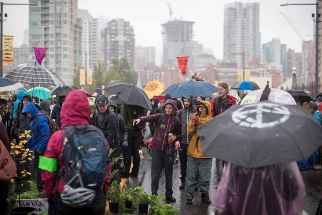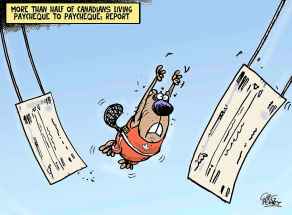Child poverty festers in Manitoba Churchill-Keewatinook Aski federal riding with highest percentage in Canada; Winnipeg-Centre, Dauphin-Swan River-Neepawa among five worst in national group's report
Read this article for free:
or
Already have an account? Log in here »
To continue reading, please subscribe:
Monthly Digital Subscription
$0 for the first 4 weeks*
- Enjoy unlimited reading on winnipegfreepress.com
- Read the E-Edition, our digital replica newspaper
- Access News Break, our award-winning app
- Play interactive puzzles
*No charge for 4 weeks then price increases to the regular rate of $19.00 plus GST every four weeks. Offer available to new and qualified returning subscribers only. Cancel any time.
Monthly Digital Subscription
$4.75/week*
- Enjoy unlimited reading on winnipegfreepress.com
- Read the E-Edition, our digital replica newspaper
- Access News Break, our award-winning app
- Play interactive puzzles
*Billed as $19 plus GST every four weeks. Cancel any time.
To continue reading, please subscribe:
Add Free Press access to your Brandon Sun subscription for only an additional
$1 for the first 4 weeks*
*Your next subscription payment will increase by $1.00 and you will be charged $16.99 plus GST for four weeks. After four weeks, your payment will increase to $23.99 plus GST every four weeks.
Read unlimited articles for free today:
or
Already have an account? Log in here »
Hey there, time traveller!
This article was published 07/10/2019 (2262 days ago), so information in it may no longer be current.
OTTAWA — A national anti-poverty group says the Liberals’ much-hailed baby-bonus boost has had limited impact, with Manitoba again topping the charts for child poverty.
“I was surprised by how small the changes are, and especially that there had been increases (in poverty) in some ridings,” said Sid Frankel, a University of Manitoba social work professor and member of Campaign 2000’s steering committee.

That national advocacy group updated its metrics of child poverty using 2017 data, following a similar study of 2015 metrics. It found that once again, Manitoba’s North is the poorest region in the country, the situation in downtown Winnipeg has only slightly improved — and the problem is even worse near Dauphin.
In 2015, the riding of Churchill-Keewatinook Aski came in at 64.2 per cent children living in poverty, which two years later fell slightly to 63.6 per cent.
“They’re devastating numbers,” said the riding’s NDP MP, Niki Ashton, who said Ottawa needs to spend more on housing, health care and child-welfare prevention programs.

!function(e,t,s,i){var n=”InfogramEmbeds”,o=e.getElementsByTagName(“script”)[0],d=/^http:/.test(e.location)?”http:”:”https:”;if(/^/{2}/.test(i)&&(i=d+i),window[n]&&window[n].initialized)window[n].process&&window[n].process();else if(!e.getElementById(s)){var r=e.createElement(“script”);r.async=1,r.id=s,r.src=i,o.parentNode.insertBefore(r,o)}}(document,0,”infogram-async”,”https://e.infogram.com/js/dist/embed-loader-min.js”);
Meanwhile, Winnipeg Centre held its No. 3 spot at 40.5 per cent in 2017, down from 41.1. The riding of Dauphin-Swan River-Neepawa is worse, with 37.5 per cent poverty in 2017, compared with 33.8 in 2015.
That’s despite the Trudeau government introducing the Canada Child Benefit in July 2016, an annual tax-free payment of up to $6,400 per child under the age of six, and $5,400 per child between the ages of six and 17.
The program replaced a Stephen Harper government-era benefit by introducing a sliding scale that gave poor families more.

The Liberals promote the CCB endlessly, and have raised its funding twice to account for inflation. They claim the benefit lifted 278,000 children out of poverty, but they use a different metric than Campaign 2000, which began in 1991 out of concern about the lack of government progress in addressing child poverty.
Winnipeg Centre MP Robert-Falcon Ouellette said the CCB is a source of pride for his government, which he said had to fight to make sure the provinces would not claw back for people receiving benefits.
He said constituents have claimed their children would likely have been apprehended by child-welfare agencies had they not received the CCB, particularly in light of a provincial benefit freeze.
“This program is probably keeping a lot of families above the water level,” said Ouellette, who also accused Frankel of being affiliated with union groups and motivated to support the NDP.

!function(e,t,s,i){var n=”InfogramEmbeds”,o=e.getElementsByTagName(“script”)[0],d=/^http:/.test(e.location)?”http:”:”https:”;if(/^/{2}/.test(i)&&(i=d+i),window[n]&&window[n].initialized)window[n].process&&window[n].process();else if(!e.getElementById(s)){var r=e.createElement(“script”);r.async=1,r.id=s,r.src=i,o.parentNode.insertBefore(r,o)}}(document,0,”infogram-async”,”https://e.infogram.com/js/dist/embed-loader-min.js”);
Frankel responded that he’s been critical of past provincial NDP governments and does not have a party membership. “I think (Ouellette) is trying to shoot the messenger,” he said.
For Frankel, the issue is the CCB is targeted at the middle class instead of being focused on ending poverty.
“The poverty-reduction effect is kind of residual; it’s not the main purpose of the benefit and it’s not the main effect we’re seeing," he said.
A measure of poverty
OTTAWA — The federal Liberals and Campaign 2000 disagree over how to measure poverty.
The advocacy group’s metric is the Census Family Low-Income Measure, tabulated based on family sizes and median incomes after taxes.
That metric puts the child-poverty rate at 18.7 per cent for all children under 18 years of age, and 28.1 per cent in Manitoba in 2017.
OTTAWA — The federal Liberals and Campaign 2000 disagree over how to measure poverty.
The advocacy group’s metric is the Census Family Low-Income Measure, tabulated based on family sizes and median incomes after taxes.
That metric puts the child-poverty rate at 18.7 per cent for all children under 18 years of age, and 28.1 per cent in Manitoba in 2017.
Last year, the Liberals set a poverty line based around the Market Basket Measure, which tabulates how many households can afford food, shelter and necessities with their post-tax income.
Under the government’s metric, nine per cent of children lived in poverty nationwide in 2017, and 9.5 per cent of children in Manitoba. Under that metric, 278,000 children were lifted out of poverty that year.
The Pallister government has previously said Ottawa’s measurement is more useful, accounting for different jurisdictions’ living costs.
Yet Frankel said the CFLIM is a more accurate look at the impact of living on a pittance.
“It’s a more comprehensive measure that looks at all aspects of poverty, not just the material deprivation,” he said.
He noted that Ottawa’s metric excludes First Nations reserves and the territories, as there is not enough data gathered on living expenses, a point NDP MP Niki Ashton said was “not shocking” for northern Manitoba.
“This is a government that’s used all the right words when it comes to First Nations, and hasn’t delivered,” Ashton said.
— Dylan Robertson
Ashton argued that in her riding, the CCB isn’t having an effect because First Nations people on reserves are not filing their taxes — and thus not receiving the benefit — because many don’t have substantial incomes to declare.
She wants the CCB reformed, or at least have federal agencies make more of an effort to get reserves residents to file tax returns.
Employment and Social Development Canada noted that Budget 2018 allocated $17 million over three years for outreach and political projects to reach Indigenous people, both in the North and in cities.
ESDC and the Canada Revenue Agency say they’ve been able to connect with close to 700 Indigenous communities over a 12-month period to get more people on the tax rolls and aware of various benefits, a project for which Ouellette said he’d advised the CRA.
Monday’s report notes child poverty is concentrated in certain ridings, and used Winnipeg as an example. While the west Winnipeg Charleswood-St. James-Assiniboia-Headingley riding and northeast Winnipeg Kildonan-St. Paul riding rank at 15 and 16 per cent of children living in poverty, the number is double for the North End, and even worse downtown.
dylan.robertson@freepress.mb.ca
Campaign 2000 report on child poverty by riding










